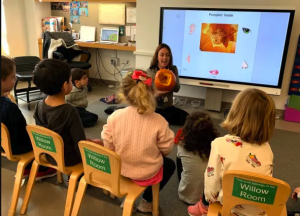Thanks to Ms. Homlish and Ms. Fell for this story.
This week, students in the Willow Room became pumpkin experts! Students used their five senses to explore the inside and outside of a pumpkin, a very concrete example of Gaynor’s multisensory approach to learning.
The class noticed the pumpkin was orange, smooth, and hard with lines on the outside. The inside was slimy, wet, stringy and had seeds. Everyone smelled and touched the inside and outside of the pumpkin and got to dig out all of the seeds. They discovered that the pumpkin did not have a sound, but that it could be used to make sounds (by drumming on it). The inside had a smell that most of the class liked.
When asked why a multisensory approach is so important, Ms. Homlish responded, “Using all five senses, especially touch, to explore the pumpkin builds a lot of new vocabulary. Ms. Fell and I used what the students noticed to teach about the parts and life cycle of a pumpkin. For example, the slimy, stringy, wet, orange ‘stuff’ inside the pumpkin are fibrous strands and the bumpy lines on the outside of the pumpkin are called ribs.”
The students were able to experience firsthand the cycle from seed, to vine, to flower, to pumpkin. By learning about the life cycle, students understood that the rough brown part on the bottom of a pumpkin is where the flower was and the stem was attached to the vine. And, Ms. Homlish continued, “Also, reaching inside the pumpkin to pull out the seeds is just fun (and messy)!”
In cooking, the students could incorporate their sense of taste. They used the seeds from the pumpkin to make Cinnamon Toast Pumpkin Seeds. Ms. Homlish said the class decided the baked seeds were “sweet, crunchy and delicious.”
The class is excited to try more pumpkin treats, and wanted to share their pumpkin seeds recipe with everyone (see below)!


